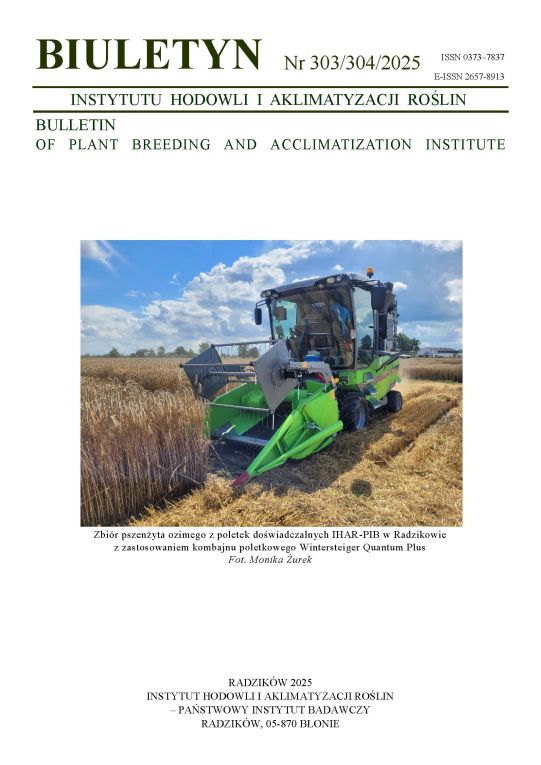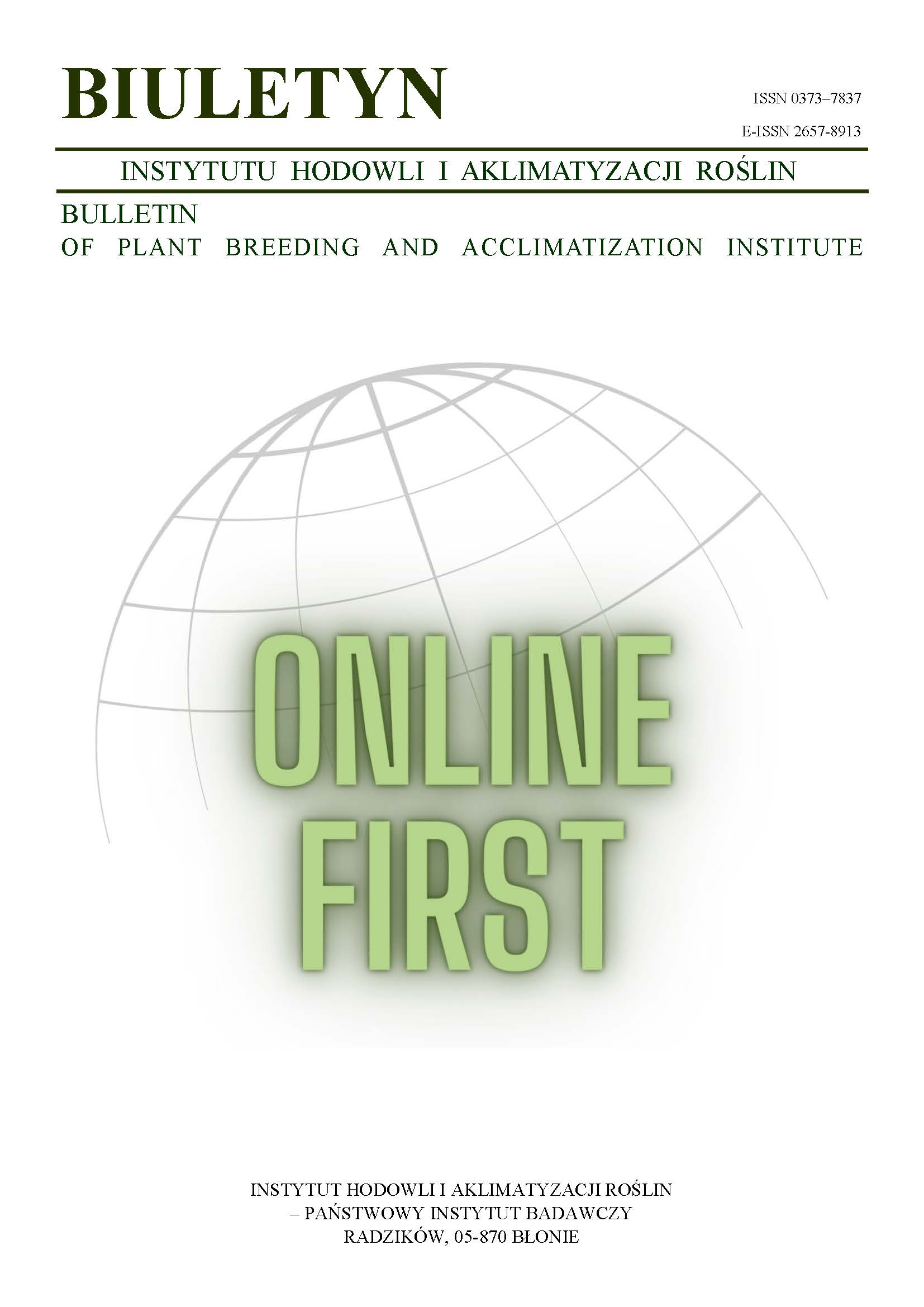Assessment of the combining ability of selected highbush blueberry (Vaccinium corymbosum L.) parental forms for seedling’s growth
Stanisław Pluta
Stanislaw.Pluta@inhort.plInstytut Ogrodnictwa, ul. Konstytucji 3 Maja 1/3, 96‒100 Skierniewice (Poland)
http://orcid.org/0000-0003-2837-7304
Łukasz Seliga
Instytut Ogrodnictwa, ul. Konstytucji 3 Maja 1/3, 96‒100 Skierniewice (Poland)
http://orcid.org/0000-0002-1687-5499
Abstract
The aim of the study was to determine the breeding value of 12 highbush blueberry (Vaccinium corymbosum L.) parental genotypes based on the estimation of their general and specific combining ability (GCA and SCA) for seedling growth. The research material was a population of 2,100 F1 plants obtained from the 2014 crossing program. Crosses of 7 maternal forms (♀) - ‚Aurora’, ‚Bluecrop’, ‚Brigitta Blue’, ‚Chandler’, ‚Draper’, ‚Duke’, ‚Northland’ - and 5 paternal forms (♂) - ‚Earliblue’, ‚KazPliszka’, ‚Polaris’, ‚Toro’, ‚Weymouth’ - were made in a factorial design (7x5). In autumn 2014, the field experiment was established in complete randomized block design, in 4 replications, with 15 seedlings per plot. In 2019, a phenotypic evaluation of the seedling population was done for plant growth . We found that the seedlings differed significantly in this plant morphological trait. Based on the results of the phenotypic evaluation of the seedling population, the GCA effects for 12 parental cultivars and SCA effects for 35 hybrid families for this trait were determined. Statistical analysis showed that the parental forms differed significantly in their combining ability (GCA and SCA effects) for plant growth. The parental forms possessing significant and positive values of GCA effects were potentially useful donors of genes determining strong growth, while, conversely, significant and negative effects in other parental forms influenced the deterioration of this trait in the assessed offspring. Statistically significant positive or negative values of SCA effects were the results of genetic interaction of both parental forms within these hybrid families, and could, therefore, inform the breeder of the improvement or deterioration of plant growth in blueberry seedlings.
Supporting Agencies
Keywords:
highbush blueberry, breeding, GCA, phenotypic evaluation, plant growth, SCAReferences
Baker, R.J. (1978) . Issues in diallel analysis. Crop Science, 18 (4): 533‒536. http://dx.doi.org/10.2135/cropsci1978.0011183x001800040001x
Google Scholar
Bestfleisch, M., Möhring, J., Hanke, M.V. (2014). A diallel crossing approach aimed on selection for ripening time and yield in breeding of new strawberry (Fragaria × ananassa Duch.) cultivars. Plant Breeding 133: 115‒120. https://doi.org/10.1111/pbr.12120
Google Scholar
Caliński, T., Czajka, S., Kaczmarek, Z., Krajewski, P. (2003). Podręcznik użytkowania programu SERGEN 4. Metodyka statystyczna i obsługa programu SERGEN (Wersja 4 dla Windows) przeznaczonego do serii doświadczeń odmianowych i genetyczno-hodowlanych. Wyd. IGR PAN w Poznaniu. ss 77.
Google Scholar
Griffing, B. (1956)a. A generalised treatments of diallel crosses in quantitative inheritance. Heredity 10:31‒50 http://dx.doi.org/10.1038/hdy.1956.2
Google Scholar
Griffing, B. (1956)b. Concept of general and specific combining ability in relation to diallel crossing systems. Austr. J. Biol. Sci. 9: 463‒493. http://dx.doi.org/10.1071/bi9560463
Google Scholar
Hortyński, J.A., 1987. Dziedziczenie niektórych cech ilościowych truskawki (Fragaria x ananassa Duch.). Metody i problemy oszacowań. Praca hab. Wyd. AR Lublin.
Google Scholar
Masny, A., Mądry, W., Żurawicz, E. (2005). Combining ability analysis of fruit field and fruit quality in ever-bearing strawberry cultivars using an incomplete diallel cross design. Journal of Fruit and Ornamental Plant Research 13: 5‒17.
Google Scholar
Masny, A., Mądry, W., Żurawicz, E. (2008). Combining ability for important horticultural traits in medium and late-maturing strawberry cultivars. Journal of Fruit and Ornamental Plant Research 16: 133‒152.
Google Scholar
Masny, A., Mądry, W., Żurawicz, E. (2014). Combining ability of selected dessert strawberry cultivars with different fruit ripening periods. Acta Scientiarum Polonorum Hortorum Cultus 13 (1): 67‒78.
Google Scholar
Masny, A., Pruski, K., Żurawicz, E., Mądry, W. (2016). Breeding value of selected dessert strawberry (Fragaria × ananassa Duch.) cultivars for ripening time, fruit yield and quality. Euphytica 207: 224‒243. http://dx.doi.org/10.1007/s10681‒016‒1690‒6
Google Scholar
Mądry, W., Ubysz-Borucka, L. (1982). Biometryczna analiza zdolności kombinacyjnej w niekompletnym układzie diallel cross. Cz. I. Model stały dla cech ilościowych. Rocz. Nauk Roln. Ser. A 105: 9‒27.
Google Scholar
Mądry, W., Krajewski, P., Pluta, S., Żurawicz, E. (2004). Wielocechowa analiza wartości hodowlanej i zróżnicowania genetycznego odmian porzeczki czarnej (Ribes nigrum L.) na podstawie efektów ogólnej zdolności kombinacyjnej. Acta Scient. Polon. Hortorum. Cultus 3: 93‒109.
Google Scholar
Mądry, W., Talbot, M., Ukalski, K., Drzazga, T., Iwańska, M. (2006). Podstawy teoretyczne znaczenia efektów genotypowych i interakcyjnych w hodowli roślin na przykładzie pszenicy ozimej. Biuletyn IHAR, nr 240/241: 13‒32.
Google Scholar
Pliszka, K. (2002). Borówka wysoka, czyli amerykańska. Wyd. Działkowiec sp. z o.o. Warszawa.
Google Scholar
Pluta, S., Mądry, W., Żurawicz, E. (1993). Zdolność kombinacyjna w hodowli twórczej porzeczki czarnej. Zeszyty Naukowe AR we Wrocławiu, Rolnictwo LVIII, nr 223: 367‒373.
Google Scholar
Pluta, S. (1994). Analiza dialleliczna wybranych form rodzicielskich porzeczki czarnej (Ribes nigrum L.) pod względem najważniejszych cech użytkowych. Praca doktorska, Instytut Sadownictwa i Kwiaciarstwa Skierniewicach.
Google Scholar
Pluta, S., Mądry, W., Zurawicz, E. (2008). General combining ability of selected blackcurrant (Ribes nigrum L.) genotypes in breeding for dessert quality fruit Acta Hort. 777: 57‒62. http://dx.doi.org/10.17660/actahortic.2008.777.4.
Google Scholar
Pluta, S., Studnicki, M., Mądry, W., Żurawicz, E. (2014). Combining Ability Analysis for Selected Plant Traits in Gooseberry. J. Amer. Soc. Hort. Sci. 139: 325‒335. http://dx.doi.org/10.21273/jashs.139.3.325
Google Scholar
Pluta, S. and Żurawicz, E. (2014). The high-bush (Vaccinium corymbosum L.) breeding programme in Poland. Acta Hort. 1017:177‒180 http://dx.doi.org/10.17660/actahortic.2014.1017.20.
Google Scholar
Sherrif, N.M., Appadurai, R., Rangasamy, M. (1985). Combining ability in sunflower. Indian, J. Agric. Sci. 55: 315‒318.
Google Scholar
Simpson, D.W. and Sharp, D.S. (1988). The inheritance of fruit yield and stolon production in everbearing strawberries. Euphytica 38: 65‒74. http://dx.doi.org/10.1007/bf00024812.
Google Scholar
Smolarz, K. (2000). Borówka wysoka. Zeszyty Pomologiczne. ISK Skierniewice.
Google Scholar
Smolarz, K. (2003). Wybór i przygotowanie pola pod plantację borówki. Hasło Ogrodnicze 10: 61‒62.
Google Scholar
Smolarz, K. (2006). History of highbush blueberry (V. corymbosum L.) growing in Poland. Acta Hort. 715: 313‒316. http://dx.doi.org/10.17660/actahortic.2006.715.46.
Google Scholar
Smolarz, K. and Pluta, S. (2014). Cultivation of the high-bush blueberry in Poland. Acta Hort. 1017: 199‒204 http://dx.doi.org/10.17660/actahortic.2014.1017.24.
Google Scholar
Spangelo, L.P., Watkins, R., Hsu, C.S., Fejer, S.O. (1971). Combining ability analysis in the cultivated strawberry. Can. J. Plant Sci. 51: 377‒383 http://dx.doi.org/10.4141/cjps71‒075.
Google Scholar
Sprague, G.F. and Tatum, L.A. (1942). General vs. Specific combination ability in single crosses of corn. J. Amer. Soc. Agron. 34: 923‒932 http://dx.doi.org/10.2134/agronj1942.00021962003400100008x.
Google Scholar
Ubysz-Borucka, L., Mądry, W., Muszyński, S. (1985). Podstawy statystyczne genetyki cech ilościowych w hodowli roślin. Wydawnictwo SGGW-AR, Warszawa: ss 220.
Google Scholar
Vieira, R.A., Scapim, C.A., Moterle, L.M., Tessmann, D.J., Conrado, T.V., Amaral Jnior, A.T. (2009). Diallel analysis of leaf disease resistance in inbred Brazilian popcorn cultivars. Genetics and Molecular Research. Genetics and Molecular Research 8 (4): 1427‒36 http://dx.doi.org/10.4238/vol8‒4gmr655
Google Scholar
Żurawicz, E. (1990). Dziedziczenie najważniejszych cech użytkowych truskawki (Fragaria x ananassa Duch.). Praca hab., ISK Skierniewice.
Google Scholar
Żurawicz, E., Mądry, W., Pluta, S. (1996). Variation and heritability of economically important traits in black currant (Ribes nigrum L.) evaluated in a diallel cross design. Euphytica 91: 219‒224.
Google Scholar
Żurawicz, E., Masny, A., Madry, W. (2006). Usefulness of selected strawberry (Fragaria·ananassa) genotypes for breeding late ripening cultivars. Acta Hort. 708:501–505 http://dx.doi.org/10.17660/actahortic.2006.708.88.
Google Scholar
Authors
Stanisław PlutaStanislaw.Pluta@inhort.pl
Instytut Ogrodnictwa, ul. Konstytucji 3 Maja 1/3, 96‒100 Skierniewice Poland
http://orcid.org/0000-0003-2837-7304
Authors
Łukasz SeligaInstytut Ogrodnictwa, ul. Konstytucji 3 Maja 1/3, 96‒100 Skierniewice Poland
http://orcid.org/0000-0002-1687-5499
Statistics
Abstract views: 299PDF downloads: 302 PDF downloads: 48
License
Copyright (c) 2020 Stanisław Pluta

This work is licensed under a Creative Commons Attribution-ShareAlike 4.0 International License.
Upon submitting the article, the Authors grant the Publisher a non-exclusive and free license to use the article for an indefinite period of time throughout the world in the following fields of use:
- Production and reproduction of copies of the article using a specific technique, including printing and digital technology.
- Placing on the market, lending or renting the original or copies of the article.
- Public performance, exhibition, display, reproduction, broadcasting and re-broadcasting, as well as making the article publicly available in such a way that everyone can access it at a place and time of their choice.
- Including the article in a collective work.
- Uploading an article in electronic form to electronic platforms or otherwise introducing an article in electronic form to the Internet or other network.
- Dissemination of the article in electronic form on the Internet or other network, in collective work as well as independently.
- Making the article available in an electronic version in such a way that everyone can access it at a place and time of their choice, in particular via the Internet.
Authors by sending a request for publication:
- They consent to the publication of the article in the journal,
- They agree to give the publication a DOI (Digital Object Identifier),
- They undertake to comply with the publishing house's code of ethics in accordance with the guidelines of the Committee on Publication Ethics (COPE), (http://ihar.edu.pl/biblioteka_i_wydawnictwa.php),
- They consent to the articles being made available in electronic form under the CC BY-SA 4.0 license, in open access,
- They agree to send article metadata to commercial and non-commercial journal indexing databases.
Most read articles by the same author(s)
- Stanisław Pluta, Wiesław Mądry, Edward Żurawicz, Marcin Kozak, Statistical assessment of determination of fruit yield in blackcurrant (Ribes nigrum L.) by two multiplicative yield components , Bulletin of Plant Breeding and Acclimatization Institute: No. 249 (2008): Regular issue
- Bogumiła Badek, Stanisław Pluta, Małgorzata Korbin, Characteristics of molecular markers linked with the resistance to gall mite (Cecidophyopsis ribis) , Bulletin of Plant Breeding and Acclimatization Institute: No. 286 (2019): Special issue
- Stanisław Pluta, Danuta Kucharska, Łukasz Seliga , Evaluation of the genetic potential of selected genotypes of highbush blueberry (Vaccinium corymbosum L.) based on a factorial crossing design , Bulletin of Plant Breeding and Acclimatization Institute: No. 286 (2019): Special issue
- Danuta Kucharska, Danuta Wójcik, Stanisław Pluta, Łukasz Seliga, Lucyna Ogórek, Barbara Wiosna, Stanisław Bodek, The analysis of factors determining in vitro and in vivo organogenesis of gooseberry (Ribes grossularia L.), genetic and phenotypic assessment of obtained material , Bulletin of Plant Breeding and Acclimatization Institute: No. 286 (2019): Special issue
- Wiesław Mądry, Marcin Kozak, Stanisław Pluta, Edward Żurawicz, The use of sequential yield component analysis (SYCA) in studies on determination of fruit yield variability in blackcurrant (Ribes nigrum L.) , Bulletin of Plant Breeding and Acclimatization Institute: No. 226/227 (2003): Regular issue














